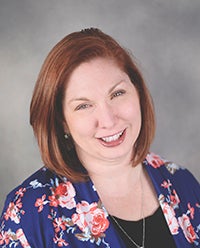Live United: Education is the greatest predictor of breaking the cycle – Albert Lea Tribune
Live United: Education is the greatest predictor of breaking the cycle ... Albert Lea Tribune


Live United: Education is the greatest predictor of breaking the cycle
Published 8:45 pm Friday, December 1, 2023
Introduction
Live United by Erin Haag
Years ago, I worked for the Austin School District with Adult Basic Education. My office was down the hall from our English Language Learning program. J. was a student that made many people nervous. Gang tattoos covered his neck and hands. His teeth were broken, his nose crooked. He never smiled and rarely spoke. If someone attempted to make conversation during breaks, he’d stare at them.
The Power of Education
Some of our students were tough. They were war-hardened, having survived atrocities that most of us can’t even begin to imagine. Those students steered clear of J. Tough recognized tougher.
Building Trust and Protection
One day, he stopped and looked hard at me. I was a little nervous and asked him if he needed help. He didn’t respond to me, and walked off. Later that evening, an argument broke out between two students. They were yelling at each other, and I was in between them. J. spoke up. I have no idea what he said, as it was in Spanish. The two students didn’t know either since they spoke Sudanese. It didn’t matter. One word from him, and they fell silent. He came to me and took me by the elbow, and said, “Here little mama.” He steered me to my office, and had me sit down. Then he left.
From that hard look, the moment that he realized I was pregnant, he was a protector. “Yo little mama” was my greeting most days. I’d come back to my desk to find a cup of water. After class, he’d take my elbow, and walk me across a dark and often icy parking lot. There were no heart-to-heart conversations, no chit chat. He didn’t soften his attitude, and there were no friendships developed with me or anyone else. I was little mama though, and I was under his protection. My husband picked me up once, and he still walked me out, and delivered me to my husband. That’s the one and only time my husband has ever expressed a hint of concern about anyone I’ve worked with.
The Power of Education: Breaking the Cycle
My job evolved and my office changed to a different location. I didn’t see J. anymore, as we were on opposite schedules and opposite locations. One day, though, his teacher said, “Read this.” She handed me an essay that J. had written. I wish with all my heart I had a copy of it. This man wrote of coming to the United States as a young child. His father had been killed, so he was the man of the family, trying to care for his mother and his younger siblings. He wrote of the little boat in the water, and of the blue-painted shed with the holes in the side. He’d keep watch while his mother slept.
Through sheer grit and determination, he made it here with his family. He worked. His mother went to college and got a job. His siblings went to college. They took citizenship classes.
Only after all of that did he sit down and decide it was time for him to learn English. He started at the lowest level of classes. By the time my daughter was born, he had worked his way up to the highest class and had written that essay. I wish I knew the rest of his story, but our paths went different ways. The last time I saw him is a core memory. I placed my newborn daughter in his arms and seeing him breathe that newborn baby smell in deep. He still wasn’t a smiler, or a talker. He breathed in deep, and told me, “Take your baby little mama” and handed her back to me and walked away.
The Importance of Early Learning
About a year later, T. came in. He wanted to get his GED, and he had just been released from prison. I laid out his options, and we made a plan together. He started working on that plan, and he was doing well. He didn’t think much of me at first, but we got there. Much like tough J., he was a protector. T. was a different kind of tough, though. He spoke in his slow drawl — yes m’mam all over the place. He brought his little brother in, and I was thrilled to be helping these brothers.
They grew up in the mountains of Tennessee. T. had about a third-grade reading level, but he was progressing nicely. Little brother? He was full of sullen attitude. It took a few days, but eventually, I realized that he was completely illiterate. There was no way he was going to admit that to me out loud. Instead, he came back in, hauled in by his brother. He struggled through the pre-testing. Eventually, he stopped trying. He’d sit there, waiting for his brother and his ride. I can see him: slouched down, wearing his too baggy jeans, white T-shirt and link chain necklace. He was done with me. Then came the day that both T. and his brother weren’t there. They had been arrested for holding a convenience store clerk at gunpoint for cash. T. was 19 years old. His little brother was
SDGs, Targets, and Indicators in the Article
1. Which SDGs are addressed or connected to the issues highlighted in the article?
- SDG 1: No Poverty
- SDG 4: Quality Education
- SDG 5: Gender Equality
- SDG 10: Reduced Inequalities
2. What specific targets under those SDGs can be identified based on the article’s content?
- SDG 1.2: By 2030, reduce at least by half the proportion of men, women, and children of all ages living in poverty in all its dimensions according to national definitions.
- SDG 4.1: By 2030, ensure that all girls and boys complete free, equitable, and quality primary and secondary education leading to relevant and effective learning outcomes.
- SDG 4.4: By 2030, substantially increase the number of youth and adults who have relevant skills, including technical and vocational skills, for employment, decent jobs, and entrepreneurship.
- SDG 5.5: Ensure women’s full and effective participation and equal opportunities for leadership at all levels of decision-making in political, economic, and public life.
- SDG 10.2: By 2030, empower and promote the social, economic, and political inclusion of all, irrespective of age, sex, disability, race, ethnicity, origin, religion, or economic or other status.
3. Are there any indicators mentioned or implied in the article that can be used to measure progress towards the identified targets?
- Indicator 1.2.1: Proportion of population living below the national poverty line, by sex and age.
- Indicator 4.1.1: Proportion of children and young people (a) in grades 2/3; (b) at the end of primary; and (c) at the end of lower secondary achieving at least a minimum proficiency level in (i) reading and (ii) mathematics, by sex.
- Indicator 4.4.1: Proportion of youth and adults with information and communications technology (ICT) skills, by type of skill.
- Indicator 5.5.1: Proportion of seats held by women in (a) national parliaments and (b) local governments.
- Indicator 10.2.1: Proportion of people living below 50 percent of median income, by age, sex, and persons with disabilities.
Table: SDGs, Targets, and Indicators
| SDGs | Targets | Indicators | ||
|---|---|---|---|---|
| SDG 1: No Poverty | SDG 1.2: By 2030, reduce at least by half the proportion of men, women, and children of all ages living in poverty in all its dimensions according to national definitions. | Indicator 1.2.1: Proportion of population living below the national poverty line, by sex and age. | ||
| SDG 4: Quality Education | SDG 4.1: By 2030, ensure that all girls and boys complete free, equitable, and quality primary and secondary education leading to relevant and effective learning outcomes. | Indicator 4.1.1: Proportion of children and young people (a) in grades 2/3; (b) at the end of primary; and (c) at the end of lower secondary achieving at least a minimum proficiency level in (i) reading and (ii) mathematics, by sex. | SDG 4.4: By 2030, substantially increase the number of youth and adults who have relevant skills, including technical and vocational skills, for employment, decent jobs, and entrepreneurship. | Indicator 4.4.1: Proportion of youth and adults with information and communications technology (ICT) skills, by type of skill. |
| SDG 5: Gender Equality | SDG 5.5: Ensure women’s full and effective participation and equal opportunities for leadership at all levels of decision-making in political, economic, and public life. | Indicator 5.5.1: Proportion of seats held by women in (a) national parliaments and (b) local governments. | ||
| SDG 10: Reduced Inequalities | SDG 10.2: By 2030, empower and promote the social, economic, and political inclusion of all, irrespective of age, sex, disability, race, ethnicity, origin, religion, or economic or other status. | Indicator 10.2.1: Proportion of people living below 50 percent of median income, by age, sex, and persons with disabilities. |
Behold! This splendid article springs forth from the wellspring of knowledge, shaped by a wondrous proprietary AI technology that delved into a vast ocean of data, illuminating the path towards the Sustainable Development Goals. Remember that all rights are reserved by SDG Investors LLC, empowering us to champion progress together.
Source: albertleatribune.com

Join us, as fellow seekers of change, on a transformative journey at https://sdgtalks.ai/welcome, where you can become a member and actively contribute to shaping a brighter future.








